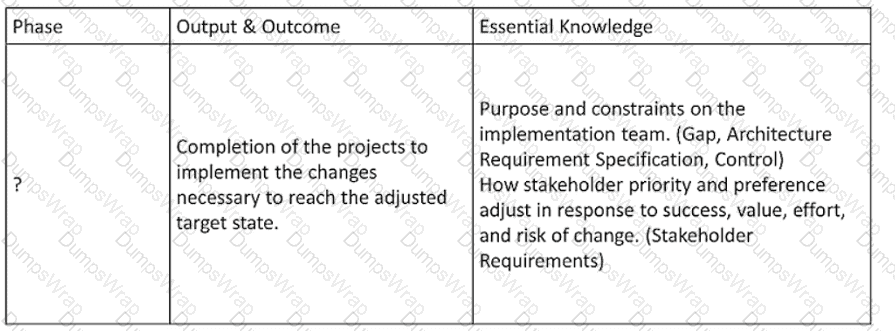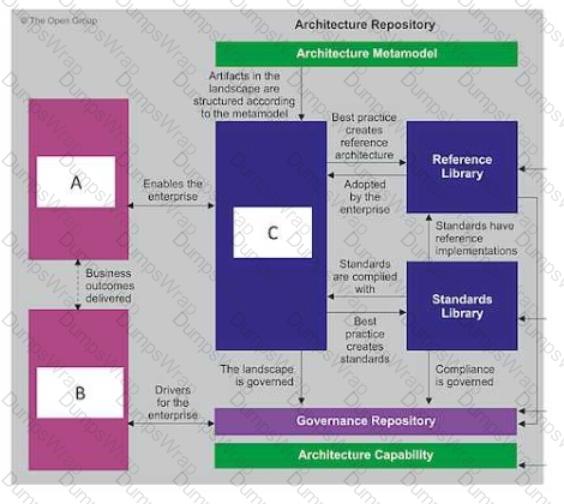TOGAF Enterprise Architecture Part 1 Exam (English) Questions and Answers
Consider the following statement:
According to the TOGAF Standard a governed approach of a particular deliverable will ensure a system of continuous monitoring to check integrity changes decision-making and audit of all architecture-related activities
Which deliverable is being referred to?
Complete the sentence. The purpose of the Gap Analysis technique is to _____.
Refer to the table below:

Which ADM Phase does this describe?
Which of the following best describes the purpose of the Gap Analysis technique?
Complete the sentence The TOGAF standard covers the development of four architecture domains. Business. Data, Technology and__________________.
Complete the following sentence:
Presenting different_________and_________to stakeholders helps architects to extract hidden agendas principles and requirements that could impact the final Target Architecture
In which phase(s) of the ADM would you deal with the actions resulting from a transformation readiness assessment?
Consider the illustration.

What are the items labelled A B and C?
Complete the sentence. The purpose of the Preliminary Phase is to develop the:
Consider the following statement.
According to the TOGAF standard, a governed approach of a particular deliverable will ensure adherence to the principles, standards, and requirements of the existing or developing architectures.
Which deliverable does this refer to?
Complete the sentence A set of architecture principles that cover every situation perceived meets the recommended criteria of_______________
According to the TOGAF standard, what term describes an individual with an interest in a system?
Consider the following statement:
Separate projects may operate their own ADM cycles concurrently, with relationships between the different projects
What does it illustrate?
Which ADM Phase includes initial implementation planning?
How does an Enterprise (Architecture) Metamodel provide value?
Complete the sentence Business Transformation Readiness Assessment is_________________.
What can architects present to stakeholders to extract hidden agendas, principles, and requirements that could impact the final Target Architecture?
The_________________ensures that a project transitioning into implementation also smoothly transitions into appropriate Architecture Governance.
Which section of the TOGAF template for Architecture Principles should highlight the business benefits of adhering to the principle?
In the ADM, what is the name for documents that are not finished and not approved?
In which section of the TOGAF template for Architecture Principles would a reader find the answer to the question of “How does this affect me?”
Complete the sentence. The purpose of the Gap Analysis technique is to
Consider the following statements about Architecture Partitioning:
The TOGAF ADM requires a partitioning model for architecture development
Architectures are partitioned when different teams need to work on different elements of the architecture at the same time
Partitions can be used to facilitate architecture re-use
Which statements are correct?
When considering the scope of an architecture, what dimension is about the extent of the enterprise?
Consider the following extract of the purpose of an ADM Phase:
Phase Output & Outcome / Essential Knowledge
? — “A set of work packages that address the set of gaps, with an indication of value produced and effort required, and dependencies between the work packages to reach the adjusted target.”
What ADM Phase is this?
Which of the following best describes the purpose of the Architecture Requirements Specification?
Complete the sentence. The architecture domains that are considered by the TOGAF standard as subsets of an overall enterprise architecture are Business, Technology,
Complete the sentence. Risks are identified as part of:
Which statement best summarizes the TOGAF Content Framework?
Which of the following are two of the architecture domains that are considered as subsets of an overall Enterprise Architecture?
Consider the following statements describing the TOGAF ADM:
All ADM activities are carried out within an iterative cycle of continuous architecture definition and realization
The Requirements Management phase is a continuous phase
Output from an early phase may be modified in a later phase
When a phase starts, the previous phase closes
Which statements are correct?
Consider the following statements:
1. Each contracted party is required to act responsibly to the organization and its stakeholders.
2. All decisions taken, processes used, and their implementation will not be allowed to create unfair advantage to any one particular party.
3. Digital Transformation and operations will be more effective and efficient.
4. Strategic decision-making by C-Level executives and business leaders will be more effective.
Which statements highlight the value and necessity for Architecture Governance to be adopted within organizations?
Which section of the TOGAF template for Architecture Principles should describe the relationship to other principles?
Complete the sentence. The purpose of Enterprise Architecture is to
What ensures that a project transitioning into implementation also smoothly transitions into appropriate Architecture Governance?
Exhibit
Consider the illustration showing an architecture development cycle Which description matches the phase of the ADM labeled as item 1?
Consider the illustration.

What are the items labelled A, B and C?
Refer to the table below:

Which ADM Phase(s) does this describe?
Refer to the table below:

Which ADM Phase does this describe?
Complete the following sentence. In the ADM documents which are under development and have not undergone any formal review and approval process are_______________.
According to the TOGAF Standard, what are the two levels of risk that should be monitored?
In the ADM, what is the name for a document deliverable that has completed a review and is approved?
Complete the sentence. Architecture effort at the Logical abstraction level is about:

